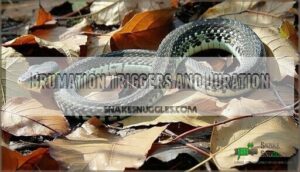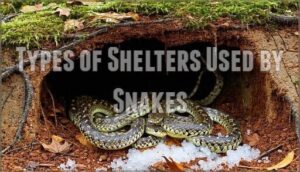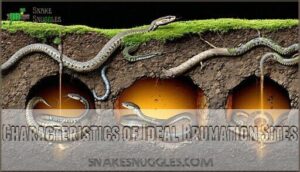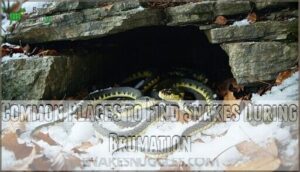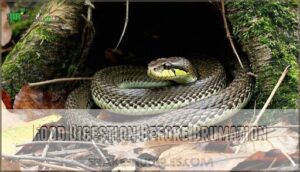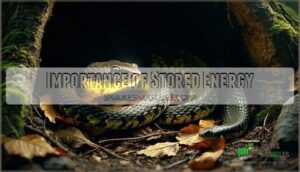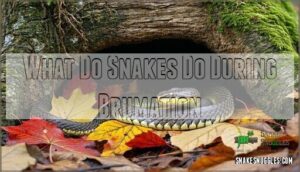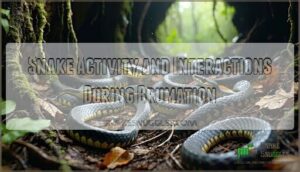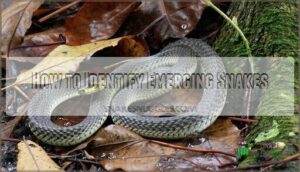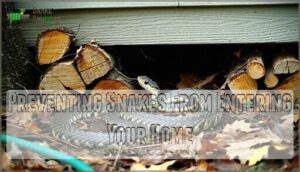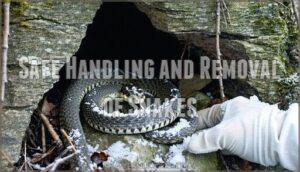This site is supported by our readers. We may earn a commission, at no cost to you, if you purchase through links.
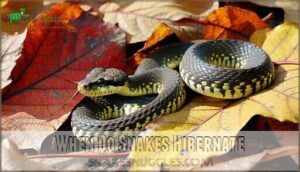 You won’t see snakes hibernate because they actually brumate instead.
You won’t see snakes hibernate because they actually brumate instead.
When temperatures drop below 60°F, typically from October through March, snakes enter this dormant state that differs from true hibernation.
Unlike hibernating mammals, snakes can still move around on warmer winter days to drink water or bask in sunlight.
The exact timing depends on your local climate and snake species – northern snakes brumate longer while southern species might skip it entirely during mild winters.
Temperature triggers this behavior more than calendar dates, so unusually warm or cold spells can shift their schedule.
Understanding where they shelter and how they prepare reveals fascinating survival strategies you might not expect.
Table Of Contents
- Key Takeaways
- What is Snake Brumation
- When Do Snakes Hibernate
- Brumation Triggers and Duration
- Where Do Snakes Brumate
- How Snakes Prepare for Brumation
- What Do Snakes Do During Brumation
- Snake Activity and Interactions During Brumation
- How to Identify Emerging Snakes
- Preventing Snakes From Entering Your Home
- Safe Handling and Removal of Snakes
- Frequently Asked Questions (FAQs)
- What is snake hibernation?
- How do snakes behave when they come out of hibernation?
- Do snakes hibernate in winter?
- How does climate affect snake hibernation?
- What month do snakes go away?
- How to tell if a snake is hibernating or just?
- What is the best time of day to avoid snakes?
- Where do snakes go in the winter months?
- Which snakes undergo hibernation?
- Do snakes hibernate in the winter?
- Conclusion
Key Takeaways
- You won’t see snakes truly hibernate – they brumate instead, entering a dormant state where they can still wake up occasionally to drink water or bask on warmer winter days
- Temperature triggers brumation more than calendar dates – when it consistently drops below 60°F (typically October through March), snakes seek underground dens, burrows, and sheltered spaces
- Northern snakes brumate for 5-8 months while southern species might skip it entirely during mild winters, showing how your local climate directly affects their dormancy patterns
- You’ll find snakes preparing by refusing food weeks before brumation begins and emerging sluggish in spring, making these transition periods when you’re most likely to encounter them around your property
What is Snake Brumation
If you’ve ever wondered what happens to snakes during winter, you’re thinking about brumation – their version of hibernation.
Unlike mammals that enter deep sleep, snakes enter a dormant state where they can still wake up occasionally to drink water or move on warmer days, which is a unique aspect of their hibernation.
Definition of Brumation
Brumation is reptilian dormancy – the snake version of hibernation. Unlike true hibernation, this low-energy state lets snakes occasionally wake up.
Here’s what happens during snake brumation:
- Metabolism drops dramatically to conserve energy
- Heart rate and breathing slow substantially
- Movement becomes minimal but awareness remains
- Body temperature matches the environment
This ectothermic survival strategy helps cold-blooded snakes endure winter’s harsh conditions without food.
How Brumation Differs From Hibernation
Unlike mammalian hibernation, snake brumation allows intermittent activity and awareness.
You’ll find key differences in how reptilian dormancy works compared to true hibernation:
- Metabolic Differences: Snakes slow their metabolism but don’t shut down completely like hibernating mammals
- Arousal Patterns: They can wake up during warm spells to drink water or move locations
- Awareness Levels: Brumating snakes remain somewhat alert to vibrations and environmental changes
- Physiological Changes: Their body temperature follows external conditions rather than maintaining internal regulation
This flexibility helps snakes survive unpredictable winter weather patterns.
Why Snakes Brumate
Nature’s survival strategy kicks in when temperatures drop and food becomes scarce.
You’ll find that snake brumation serves as an essential evolutionary advantage that helps these cold-blooded creatures survive harsh winters.
Since snakes can’t generate their own body heat, brumation becomes their primary climate adaptation tool.
Without their own internal heating system, snakes depend on brumation to survive winter’s harsh reality.
This snake dormancy allows them to conserve precious energy when hunting becomes impossible and their metabolism would otherwise demand constant fuel.
The physiological changes during snake hibernation are remarkable.
Their heart rate drops dramatically, breathing slows, and digestive processes nearly stop.
This energy conservation method transforms snakes into living batteries, running on stored fat reserves for months.
Brumation also serves reproduction.
By preserving energy through winter, snakes emerge ready to mate in spring.
This timing guarantees offspring arrive when food is abundant and temperatures support growth.
Phase Body Changes Benefits
When Do Snakes Hibernate

If you’re wondering when snakes start their winter rest, the timing depends heavily on your location and local climate conditions.
Most snakes begin brumation when temperatures consistently drop below 60°F, which typically occurs between September and December in northern regions.
Brumation Period in Northern Climates
During winter months in northern latitudes, snakes face harsh conditions that trigger their survival instincts.
Snake brumation typically begins when temperatures consistently drop below 60°F, usually between September and December.
These climate impacts force snakes to seek deeper hibernacula—underground dens that stay below the frost line.
Snakes rely on external environments, because they’re ectothermic animals, to regulate their body temperature.
Here’s what makes northern snake hibernation unique:
- Extended dormancy periods lasting 5-8 months due to prolonged freezing temperatures
- Deeper hibernacula selection at 3-6 feet underground for better thermal stability
- Group brumation behavior where multiple species share dens for warmth conservation
Snow cover actually helps by insulating hibernation sites and preventing rapid temperature swings.
Northern snakes like garter snakes show earlier emergence patterns in spring, while less cold-tolerant species wait for consistently warm weather.
The snake hibernation period can extend until April or May, though brief warm spells may cause temporary arousal for water before returning to their winter shelters.
Brumation Period in Moderate Climates
Moving from harsh northern conditions, moderate climate variations create flexible brumation periods. Your local snakes typically start winter months dormancy between October and November when temperatures drop below 60°F.
However, regional differences mean these snake hibernation months aren’t set in stone – warm spells can interrupt their rest. Snakes in colder climates require additional winter shelter to survive.
| Climate Factor | Northern vs Moderate |
|---|---|
| Brumation Length | 6-7 months vs 3-5 months |
| Winter Activity | Minimal vs Occasional basking |
| Emergence Timing | Late April vs March-April |
| Weather Flexibility | Rigid schedule vs Climate dependent |
This environmental impact on species behavior means you’ll find snake brumation varies considerably based on your location’s specific conditions.
Brumation Period in Warm Climates
If you live in Florida or Arizona, your local snakes experience what’s called Limited Brumation. This isn’t the deep winter dormancy you’d find up north. Instead, snakes in warm climates enter a lighter state of reduced activity that can last just 6-12 weeks.
Species Variations play a big role here. Ball pythons and other tropical species might skip snake hibernation entirely, while native species still respond to cooler temperatures. When winter temperatures drop near 60°F, you’ll notice changes in Activity Levels.
Coastal Brumation often means snakes stay semi-active, emerging on sunny days to bask. Microclimates Matter substantially – a snake under your deck might behave differently than one in an open field, even in the same yard.
- Temperature-dependent dormancy occurs only when temps approach 60°F consistently
- Feeding pauses last weeks rather than months during winter dormancy
- Opportunistic emergence happens during warm spells for basking
- Flexible behavior allows quick changes between rest and activity
Factors Influencing Brumation Timing
Several key factors determine when you’ll see snakes entering snake brumation. Temperature drops below 60°F trigger the process, but daylight hours, humidity levels, and rainfall patterns also play important roles.
Geographic variations mean northern snakes start earlier than southern ones.
| Environmental Factor | Impact on Timing | Example |
|---|---|---|
| Temperature | Primary trigger below 60°F | Northern regions: September-October |
| Daylight hours | Shorter days signal brumation | 10-12 hours triggers hormonal changes |
| Geographic location | Latitude affects start date | Southern snakes may skip brumation |
Environmental cues work together like a natural alarm clock, telling snakes when it’s time to find shelter for winter.
Brumation Triggers and Duration
Understanding when snakes enter brumation helps you anticipate their seasonal behavior patterns.
The timing and duration of this dormant state depend on several environmental factors that trigger their natural survival instincts, including understanding when snakes enter such states to better comprehend their behavior.
Temperature Threshold for Brumation
When temperatures consistently drop below 60°F (16°C), you’ll notice snakes starting their brumation temperature triggers.
This critical temperature threshold acts like nature’s alarm clock, signaling time for snake inactivity temperature.
Geographic variation means desert species might wait until 50°F, while northern snakes respond earlier.
Species differences also matter—garter snakes handle cooler temperature than corn snakes.
Climate change is shifting these patterns, but most snakes’ acclimation ability helps them adjust to new conditions during snake brumation.
How Long Does Brumation Last
Snake brumation duration varies substantially based on your location and snake species.
Most snakes enter this winter dormancy for 2-7 months, with northern species experiencing longer periods.
Here’s what affects brumation duration:
- Climate Influence: Colder regions extend brumation up to 7 months
- Species Variation: Different species have unique timing patterns
- Size Matters: Larger snakes often brumate longer than smaller ones
- Juvenile Length: Young snakes may have shorter brumation periods
Factors Affecting Brumation Period
While brumation duration varies substantially, you’ll find that specific factors determine how long your local snakes stay dormant. Geographic location plays the biggest role—northern snakes brumate up to six months, while southern species may skip it entirely.
Climate change affects traditional patterns, making brumation duration less predictable. Species variation matters too: garter snakes emerge earlier than rattlesnakes. Snake age influences timing, with juveniles often having shorter winter months dormancy periods.
Shelter quality directly impacts survival and duration. Here’s how key factors compare:
| Factor | Short Brumation | Long Brumation |
|---|---|---|
| Location | Southern regions | Northern climates |
| Species | Garter snakes | Rattlesnakes |
| Age | Juvenile snakes | Adult snakes |
Understanding these climate dependent and species specific variations helps you predict when snake brumation occurs in your area.
Where Do Snakes Brumate
You’ll find snakes seeking shelter in underground dens, rock crevices, and protected spaces when temperatures drop below 60°F.
These hibernacula, range from natural burrows and fallen logs to human-made structures like basements and garages, serving as hibernation sites.
Types of Shelters Used by Snakes
When you’re searching for winter shelter, snakes become master architects of survival.
They’ll select from three main hibernaculum categories: Natural Hibernacula like caves and Underground Burrows, Artificial Shelters including basements and foundations, and Group Dens where multiple species share warmth.
These snake hibernation sites must provide stable Microclimate Factors below the frost line.
Many resources are available for purchasing snake hibernaculum.
- Underground burrows carved by woodchucks become cozy snake apartments with built-in insulation
- Rock piles near water sources create natural fortresses where hundreds gather for communal warmth
- Abandoned wells and snake logs offer ready-made dens with perfect temperature control year-round
Characteristics of Ideal Brumation Sites
When selecting ideal winter refuges, snakes prioritize specific environmental conditions for survival. Temperature stability remains essential – they need consistent temperatures around 50-60°F without dangerous fluctuations. Hibernacula must offer excellent predator protection through narrow entrances or hidden locations that keep threats away.
Moisture levels require careful balance; too wet causes fungal issues, while too dry leads to dehydration. Accessibility matters since snakes need multiple escape routes during emergencies. Den size should accommodate individual snakes or groups comfortably.
Underground burrows provide superior insulation compared to surface shelters. These dens must stay above freezing while remaining below ground temperature extremes. Smart snake hibernation site selection determines winter survival success.
Temperate forest snakes often exhibit site fidelity behaviors, returning to the same hibernation spots year after year.
Feature Why Important Example
Temperature Stability
Predator Protection
Moisture Levels
Common Places to Find Snakes During Brumation
You’ll find snakes in predictable spots during winter months.
These hibernaculum locations include both natural shelters and urban areas where snakes gather for survival.
Natural hibernacula offer the best protection:
- Snake caves and rock crevices that stay above freezing
- Burrows abandoned by rodents or other mammals
- Fallen logs and dense brush piles with thick insulation
Urban shelters like basements, crawl spaces, and foundation gaps also attract brumating snakes.
Group dens form when multiple species share ideal microclimate selection spots.
You’ll often discover shared hibernaculum sites where different snake species coexist peacefully through winter.
How Snakes Prepare for Brumation
Snakes prepare for winter months by digesting all remaining food and building fat reserves to survive without eating.
You’ll notice their behavior changes as they become less active and seek sheltered areas when temperatures drop below 60°F.
Food Digestion Before Brumation
Understanding where snakes shelter during brumation helps you prepare for proper snake feeding before this dormant period begins.
Your snake’s digestive tract must completely clear before temperatures drop, as their Digestive System Shutdown occurs when metabolism slows.
You’ll notice snakes refuse food 2-3 weeks before snake hibernation starts because Digestion Rate Factors like enzyme production decrease dramatically.
Any Optimal Last Meal needs full processing time, or undigested food causes snake digestive tract decay during winter sleep.
This Brumation Gut Health preparation prevents dangerous bacterial growth that could kill your snake.
This Stored Energy Impact guarantees safe snake brumation.
Importance of Stored Energy
After digesting their last meal, snakes depend on fat reserves and glucose storage built up during active months.
This metabolic slowdown reduces their energy conservation needs by up to 90%, allowing snake metabolism to sustain essential functions throughout snake hibernation.
These stored energy sources become the snake’s lifeline for snake survival during months without food, while water absorption through skin helps maintain hydration.
Changes in Snake Behavior Before Brumation
Three key behavioral shifts signal approaching brumation as snake metabolism slows.
You’ll notice your snake’s appetite disappears completely, and they’ll refuse food even when offered.
Their movement becomes increasingly sluggish as they conserve energy for winter survival.
Watch for these specific pre-brumation changes:
- Appetite Changes – Complete feeding refusal despite normal prey offerings
- Increased Basking – Extended sun exposure to absorb maximum warmth
- Seeking Shelter – Active exploration of dark, protected hiding spots
- Shedding Patterns – Final skin molt before entering dormancy
Environmental cues trigger these snake hibernation behaviors automatically.
Snake inactivity replaces normal hunting routines as reduced activity becomes their primary survival strategy.
What Do Snakes Do During Brumation
Once you understand when snakes enter brumation, you’ll want to know what actually happens during this dormant period.
Brumating snakes don’t simply sleep through winter like bears—they enter a state where their bodies slow down dramatically while still allowing for occasional activity.
Do Snakes Eat During Brumation
During brumation, snakes can’t eat because their digestive processes completely shut down. You’ll find that metabolic slowdown makes food processing impossible, even if prey were available during snake hibernation.
Here’s what happens with snake feeding during brumation:
- Energy conservation becomes the primary survival strategy through stored fat reserves
- Metabolic rate drops so dramatically that digestion can’t occur
- Water intake remains essential – they’ll wake briefly to drink when needed
- Weight loss is inevitable as they burn through fat stores over months
- Snake inactivity prevents hunting behaviors entirely during dormancy
- Snake energy conservation relies solely on pre-brumation fat accumulation
This complete feeding shutdown explains why snakes must build substantial fat reserves before entering brumation, as they’ll survive months without any food intake whatsoever.
How Snakes Survive Without Food
Snakes become survival experts through dramatic metabolic slowdown during snake brumation.
Their metabolic rate drops to just 5% of normal levels, enabling incredible energy conservation. Fat reserves built up before winter fuel their snake hibernation, while glucose storage provides emergency backup energy.
Heart rates plummet from 60-80 beats per minute to merely 5-10 beats. This snake winter survival strategy lets them fast for months without harm, as their bodies efficiently manage stored resources through reduced cellular activity and minimal movement.
Body Function Normal Activity During Brumation
Importance of Water During Brumation
While they don’t eat during snake brumation, water remains essential for survival.
You’ll notice snakes choose hibernation spots near reliable water sources because dehydration risks increase during extended dormancy periods.
Their hydration mechanisms include periodic brumation wake-ups on warmer days to drink water and prevent dangerous fluid loss.
Snake winter survival depends on these strategic drinking sessions that maintain proper body function.
Additionally, skin absorption helps snakes retain moisture from their environment during snake hibernation conditions.
Waste elimination nearly stops, but occasional water intake supports their metabolic processes and prepares them for spring emergence when normal snake hydration patterns resume.
Snakes prepare through pre-brumation dietary changes to optimize their fat reserves and ensure a successful brumation period, which is crucial for their overall health and survival.
Snake Activity and Interactions During Brumation
You’ll notice that snakes don’t completely shut down during brumation like mammals do during hibernation.
They remain somewhat aware of their surroundings and can still move around occasionally, especially on warmer days when they might emerge to bask in sunlight or interact with other snakes in their shared den, which is a key aspect of their behavior during this state of dormancy.
Importance of Basking in Sunlight
While snakes don’t eat during snake hibernation, they’ll occasionally emerge for essential snake sunbasking sessions on warm winter days.
Thermoregulation keeps their snake body temperature stable enough for survival.
Temperature regulation through basking provides critical benefits:
- Vitamin D synthesis that supports immune function during dormancy
- Energy absorption from sunlight that maintains minimal metabolic processes
- Post-brumation preparation that readies their systems for spring activity
Social Interactions Among Snakes
Winter group hibernation transforms solitary reptiles into surprisingly social communities.
You’ll find different species practicing species mixing in shared communal dens, creating temporary neighborhoods where social hierarchy emerges based on size and dominance.
| Social Behavior | Winter Benefit |
|---|---|
| Kin recognition helps families cluster | Familiar scents reduce stress hormones |
| Cooperative thermoregulation in groups | Shared body heat increases survival rates |
| Chemical marking of safe hibernacula | Future generations find proven shelter sites |
| Snake groups form lasting friendships | Preferred companions reunite each season |
| Social interactions override territorial instincts | Temporary truces enable species mixing |
These snake hibernation partnerships demonstrate remarkable social interactions that challenge assumptions about reptilian behavior during winter dormancy.
Changes in Snake Behavior During Brumation
During brumation, you’ll notice snake behavior becomes drastically different from their active seasons.
Their metabolic slowdown creates near-complete stillness, with reduced movement that makes them appear almost lifeless.
Snake sleep patterns shift as they enter extended periods of inactivity, though they’re not truly sleeping like mammals.
Water absorption through their skin continues, while waste elimination nearly stops completely.
You might observe intermittent activity on warmer days when they briefly emerge for hydration or basking before returning to their dormant state underneath logs or rocks.
How to Identify Emerging Snakes
As winter fades and temperatures rise, you’ll notice snakes beginning to emerge from their brumation hideouts between March and April.
Recognizing the signs of awakening snakes helps you stay alert during this active period when they’re searching for food, water, and mates after months of dormancy, and being aware of these signs is crucial for understanding the behavior of snakes.
Factors Triggering Emergence From Brumation
As spring arrives, multiple environmental cues signal the end of snake brumation.
Temperature increase above 60°F consistently triggers emergence, while extended daylight hours provide essential sunlight exposure for warming.
Warm weather triggers coincide with resource availability as prey becomes active again.
Hydration needs drive snakes to seek water sources after months of dormancy.
The approaching mating season creates additional motivation, making spring peak time for increased snake activity following their winter rest period.
Changes in Snake Behavior After Brumation
Warmer temperatures act like nature’s alarm clock, awakening snakes from their dormant state. You’ll witness remarkable transformations as these reptiles shift into high gear after months of inactivity.
Activity Levels surge dramatically as their metabolism kicks back into motion. Snake hibernation emergence brings noticeable changes you can observe:
- Increased snake activity – Movement becomes frequent and purposeful as they search for food
- Feeding Habits intensify – Snake foraging becomes aggressive after extended fasting periods
- Shedding Process begins – Old skin peels away, revealing fresh scales underneath
- Mating Season behaviors – Reproductive instincts drive social interactions and territorial displays
Habitat Exploration becomes a priority as snakes establish new territories and locate preferred basking spots. This postbrumation behavior marks their shift from survival mode to active living, making snake brumation emergence easy to identify, and signifies their change from dormancy to a new phase.
Warning Signs of Emerging Snakes
Recognizing snake emergence helps you stay alert during their most active period.
As temperatures climb above 60°F, you’ll spot clear indicators of Post-Brumation Behavior around your property.
Watch for these snake emergence warning signs:
- Increased Activity around water sources and sunny areas as snakes seek warmth after months underground
- Shedding Signs like old skin remnants near rock piles, woodpiles, or foundation areas where they overwintered
- Basking Frequency increases dramatically on warm spells, with snakes appearing motionless on driveways, patios, or garden paths
During Mating Season, snake activity peaks substantially.
You’ll notice more movement during warm spells as they prepare for breeding activities ahead.
Spotting discarded snake skins is a reliable sign of their presence.
Preventing Snakes From Entering Your Home
Understanding when snakes brumate helps you protect your home from these unwelcome visitors during their most vulnerable periods.
You can take simple steps to seal your property and remove attractants before snakes seek winter shelter in your warm spaces.
Sealing Entry Points
Foundation cracks and window wells create perfect snake hibernation house foundations during winter months.
Inspect your home’s perimeter and seal all pipe openings with waterproof caulk, especially where utilities enter walls. Replace damaged vent screens immediately and install weather stripping under door gaps.
Even quarter-inch openings allow snakes access to snake hibernation garages attics and snake hibernation plumbing foundations. Don’t forget chimney caps and roof vents where snakes seeking snake hibernation warm escape can squeeze through surprisingly small spaces.
Consider installing protective well coverings to prevent snakes from entering these vulnerable areas.
Removing Attractants
Limit Food sources that draw snakes to your property. Remove pet bowls, birdseed, and garbage that attracts rodents—snakes’ primary prey. One way to address this issue is by implementing effective rodent solutions.
Clear Debris creates fewer hibernation locations around houses. Stack firewood away from buildings on raised platforms. Trim overgrown vegetation and tall grass regularly.
Remove brush piles and leaf accumulations. Manage Water by fixing leaky spigots and clearing clogged gutters. Conduct thorough Yard Maintenance before snake hibernation season begins.
- Stack firewood away from buildings on raised platforms
- Trim overgrown vegetation and tall grass regularly
- Remove brush piles and leaf accumulations
- Manage Water by fixing leaky spigots and clearing clogged gutters
- Conduct thorough Yard Maintenance before snake hibernation season begins
Using Deterrents
After removing attractants, you’ll need deterrents to keep snakes away from your property during snake hibernation season.
Natural repellents like cinnamon and clove oil provide safer options, while chemical deterrents and ultrasonic devices offer varying levels of deterrent effectiveness.
Here are three proven approaches:
- Natural repellents – Apply essential oils or sulfur around your home’s perimeter to create unwelcoming scent barriers
- Physical barriers – Install fine mesh fencing or gravel strips to block access to potential hibernaculum sites
- Professional services – Hire experts to seal dens, burrows, and entry points while applying effective snake repellent solutions
Safe Handling and Removal of Snakes
When you encounter snakes during brumation periods, you’ll need professional wildlife removal services for safe handling and relocation.
Attempting DIY snake removal can result in bites, injuries, and stress to dormant snakes that are already vulnerable during their winter rest period.
Why Professional Removal is Recommended
Professional wildlife removal protects you from safety concerns and legal issues when dealing with snakes hibernating in houses.
Expertise required for proper snake identification prevents dangerous encounters, especially around snake hibernation locations.
Wildlife removal specialists handle three critical aspects:
- Equipment mastery – Professional tools guarantee safe snake removal without property damage
- Species knowledge – Accurate identification prevents mishandling venomous snakes
- Legal compliance – Permits and regulations vary by location and species
Understanding snake behavior and safe handling techniques is vital for avoiding bites.
Safe Handling Techniques
Handling Tools like thick gloves and snake hooks keep you safe during encounters.
Never try to identify species—assume danger and move slowly.
Keep first aid supplies ready for bite prevention. Use safe enclosures like containers with secure lids for temporary holding.
During snake hibernation, sluggish snakes may still bite if threatened, so maintain distance even with seemingly inactive snakes.
Humane Snake Removal Methods
When discovering snakes in snake hibernation locations houses or hibernaculum sites, safe relocation protects both parties.
Professional assistance guarantees proper identification and habitat modification around your property. Exclusion techniques prevent future encounters more effectively than snake repellents.
- Use snake bags or secure containers for non-venomous species during transport
- Apply vegetable oil to release snakes from glue traps without harm
- Contact wildlife services for venomous species or snake warm safe places in basements
- Relocate captured snakes to suitable nearby habitats with landowner permission
Frequently Asked Questions (FAQs)
What is snake hibernation?
Snake hibernation, called brumation, occurs when you see temperatures drop below 60°F. Your local snakes enter this dormant state to survive winter’s harsh conditions by dramatically slowing their metabolism.
How do snakes behave when they come out of hibernation?
Like waking giants stretching after a long slumber, you’ll notice snakes emerge sluggish and cold from their winter rest.
They’re typically very sluggish, cold, and hungry when they first emerge, spending time hunting, basking in sunny spots to warm their bodies.
Do snakes hibernate in winter?
Yes, snakes do hibernate in winter through a process called brumation.
They enter this dormant state when temperatures drop below 60°F, typically between September and December, emerging in spring when temperatures consistently warm, which is a result of their adaptation to survive the cold.
How does climate affect snake hibernation?
Climate directly controls when you’ll find snakes entering brumation. Northern regions trigger earlier hibernation around September, while southern snakes may stay active year-round due to consistently warmer temperatures.
What month do snakes go away?
You’ll typically see snakes "disappear" between October and December when temperatures consistently drop below 60°F. They enter brumation, seeking underground dens and sheltered spots to survive winter’s chill.
How to tell if a snake is hibernating or just?
A sleeping cat remains still but breathes steadily—brumating snakes show similar signs.
You’ll notice reduced movement, slower breathing, and cooler body temperature, but they’ll still respond to touch or disturbance, unlike truly dormant hibernation.
What is the best time of day to avoid snakes?
You’ll encounter fewer snakes during cooler parts of the day – early morning before 10 AM or evening after 6 PM.
Snakes are most active during warm midday hours when they’re hunting and basking in sunlight.
Where do snakes go in the winter months?
Millions of snakes vanish like ghosts when winter arrives.
You’ll find them tucked away in underground dens called hibernacula, seeking shelter in burrows, caves, rock crevices, and sometimes your basement or garage.
Which snakes undergo hibernation?
Most snakes in temperate climates undergo brumation (reptilian hibernation), including garter snakes, copperheads, corn snakes, milk snakes, grass snakes, and European vipers. Tropical snakes typically remain active year-round.
Do snakes hibernate in the winter?
Cold-climate creatures certainly choose clever hiding spots.
You’ll find snakes don’t truly hibernate like mammals, but enter brumation instead.
They become sluggish, stop eating, and seek shelter underground or in protected areas during winter months, which is a key aspect of their survival strategy, involving clever hiding spots.
Conclusion
Knowledge is power, and understanding when do snakes hibernate helps you stay prepared year-round.
You’ve learned that snakes don’t truly hibernate but brumate from October through March when temperatures drop below 60°F.
They can still move on warmer days, unlike hibernating mammals.
Northern species brumate longer while southern snakes might skip it entirely during mild winters.
Remember that temperature triggers this behavior more than specific dates.
By recognizing their shelter preferences and behavioral changes, you’ll better coexist with these fascinating reptiles in your environment.
- https://www.summitenvironmentalsolutions.com/about-us/blog/snake-control-in-the-fall-is-important/
- https://www.snakesox.com/blog/2019/4/30/when-is-snake-season-a-complete-guide-to-predicting-snake-sightings
- https://www.britannica.com/animal/snake/Dormant-periods
- https://www.discovermagazine.com/planet-earth/why-and-where-snakes-hibernate
- https://naturemuseum.org/cas/blog/what-do-snakes-do-in-the-winter

